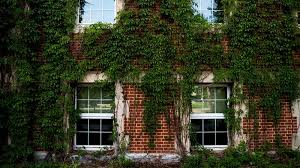Ever wondered what the “stuff” is that coats many old buildings? From tree roots to microorganisms, biological growth affects many historic buildings. Some forms are harmless, but others can cause internal and external damage to the walls of buildings.

Roots can damage buildings. This is due to the action of trees under foundations, walls and underground drains. Leaves can block drainage systems, and moisture-seeking plants such as Buddleia can cause masonry damage.
On monuments and structures, you will often find ivy or other creeping plants. This growth can get into joints, causing bricks to be displaced and mortar to crack. After removing the plant, stains are often left on the masonry. Ivy will also keep gutters away from walls, and because it shades the wall surface constantly, moisture is not able to evaporate. It is important to use ivy for decorative purposes. This means that it should be placed on a trellis, so that there is an air space between the plant’s roots and the wall.
Lichens, a combination of algae and fungus, have an aesthetic appeal that can be seen on monuments and other buildings. However, the presence of lichens may cause a degradation in roofing materials and copper and lead flashings. For Roof Cleaning Stroud, consider https://www.gloucestershireexteriorcleaning.co.uk/roof-cleaning/stroud/

Mosses are another example of a biological growth that can be found on buildings and contributes to their aesthetic appeal. The presence of moss can cause damage to roofing tiles similar to frost damage. Mossy areas can also block moisture evaporation, causing damp and blocking drainage systems.